Geist: the Sin-Eaters: 2nd Edition by That Old Tree
Introduction
Original SA post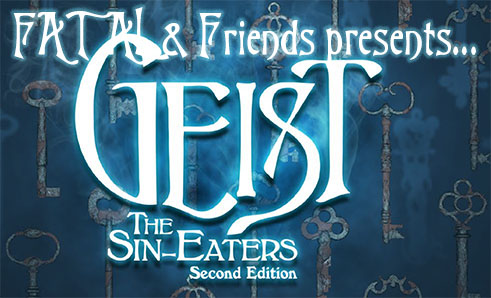
01 — Geist: the Sin-Eaters 2nd Edition — Introduction

 No bones about it!
No bones about it! 

”Nothing is born which Death makes not subject to his state.”
—Bhartrhari, “Of Time the Destroyer”
Developed by our own GimpInBlack, with an impressive authors list of voices for diversity and revolution including Vera Vartanian, James Mendez Hodes, Olivia Hill, Filamena Young, Eloy Lasanta and Chris Spivey, Geist: the Sin-Eaters 2nd Edition is one of the best of the generally quite good Chronicles of Darkness/New World of Darkness 2nd Edition game lines. I am only fairly recently deep into Chronicles and am basically totally unfamiliar with Geist 1st Edition except for second- and third-hand reports that it seems to have been kind of cool but also totally broken and sort of aimless. I can’t make much comment on that, but I can say this: Geist 2nd Edition is one of my favorite recent games. That’s why I want to talk to you about it today. Let’s
That quote up top accompanies a pretty good piece of full-page art on the very first page of the book. The next piece of meat in the book, after the credits and table of contents, is of course chapter fiction. It’s actually pretty good. Jade and Trisha, a couple of young sisters the former of which is “sensitive”, are doing the whole pajamas-and-Ouija thing. This spurs hope in Oliver, a young man’s old ghost who desperately wants to communicate with them to relieve his monotonous, repetitive, depressive, obsessive deathly existence. He likes them so much sometimes instead of re-”living” his death he watches the girls leave for school and listens to them talk about all the stuff nowadays that sounds like science-fiction to his early 20th century ears.
Things go sideways when the young ladies immediately get distracted bickering. Trish won’t even let things get started without needling Jade about this being some weird prank, and their stomping and leaning against the table makes the floorboards creak and reverberate, just like they did when some maniacal goons came to beat him into the floor and cut up his body to send his father a message. It’s too much, and in dramatic poltergeist fashion shit starts flying around the room and all the doors in the house are slamming open and closed. The girls’ father, Hari, runs out of his room to see what’s up. The circuit breakers flash, the lights go out, and Oliver, manifested in bloody horror, shambles towards them pleading for help.
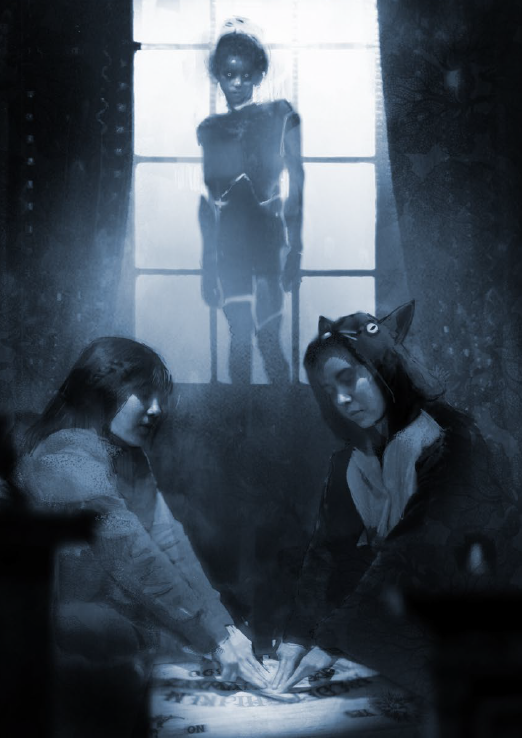
It’s hard to say which sister is which in this picture since they don’t match the descriptions in the fiction very well, but I assume Trish is the one wearing a cat pajama jumper to shit all over her sister’s Very Legitimate Ghost Concerns.
Themes posted:
Geist: The Sin-Eaters is a game about people. Some of them are alive, some of them are dead, and some of them stand between the two, but they’re all people.
Geist is about giving a voice to the voiceless, about standing up for the marginalized, about power and privilege and the responsibilities they carry with them.
Geist is a game about death.
Geist a game about hope.
Geist 2nd Edition bills itself as a game about four main themes: Empathy, Self vs. Service, Hope and Joy, and Looking Back to Look Forward. Sin-Eaters, the principal characters of Geist, have skittered along the line between life and death, made a Bargain with a powerful, Underworld-addled geist, and merged with them to struggle towards both parties’ unfinished business. They are not necessarily bleeding hearts—in fact the fucked up world they're thrust into makes that kind of a hard thing to be—but they find themselves naturally acting as intercessors between the worlds of the living and the dead. They are well aware of the capricious nature of death-in-life, and also now of the oppressive, gut-wrenching existence on the other side as a shade. Death is broken, and even if they’re not particularly altruistic, in order for Sin-Eaters to understand who they are and where they’re going, they’ll have to try to undo some of that damage for others as well as themselves.
Here we get the usual sidebar of Myth vs. Fact, so I’ll just run down the truths real quick: Sin-Eaters aren’t possessed by their geist, they’re in a partnership. They technically, according to mortal science, have “come back from the dead” but for mystical purposes they are just dead and so they’re subject to anti-dead guy magic, and their remembrances don’t feed ghosts. They’re rough and tough but they’re not immortal, and can die of old age. They obviously speak to the dead, and in fact act as focal points that make it easier for ghosts to Manifest. And they lead “death cults”, or krewes, which are sort of ancestor-worshipping groups that help them chase down ghost clues, squabble with other krewes over praxis, and win mayoral elections in order to improve both the worlds of the living and the dead.

Eh, okay now.
There’re typical sections on How to Use This Book and What Are Gaming? so we’ll just skip on ahead to Inspirational Media. Death: The Trip of a Lifetime, Expiration Date and Sparrow Hill Road are all recommended books, as are the movies Coco and ParaNorman. Mama (2013) is held up as a quintessentially Geist movie. I’ll admit I’m not a horror or scary story fan and I’m not familiar with any of these recommendations, except ParaNorman which I enjoyed quite a bit. The Lost Room is recommended not for being a ghost story (which it isn’t), but because it’s apparently full of just weird bizarre environmental stuff and strange objects. I may actually check one or two of these out, but that’s what I said about the other hundreds of things in my to-do pile.
Finally, there’s a glossary of terms that as usual can help you understand some of the stuff later in this book as you read it, but mostly just gives you a rough picture of stuff right off the bat. At least it’s not like Werewolf 2nd Edition where the glossary is two chapters and nearly 80 pages into a book filled with conlang jargon.
Next Up: I’m going to skip ahead to the setting chapter because, like a proper Sin-Eater, I am a rebel.
Chapter 2 Part 1
Original SA post
02 — Geist: the Sin-Eaters 2nd Edition — Chapter 2 Part 1

 Lethe me ask you a question.
Lethe me ask you a question. 

“Life is a promise to death.”
—Geist: the Sin-Eaters 2nd Edition
Welcome…to Deadworld!
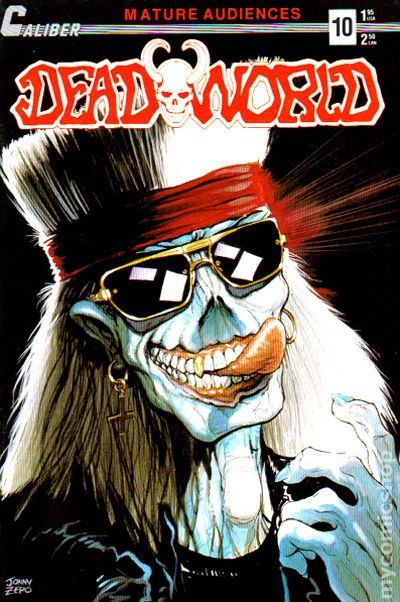
BEING ALIVE AND THEN NOT
What is it like to know about death? In Geist we start learning about the world we’ll pretend to inhabit with ruminations on how our perspectives of life and death change and grow. When you’re young, very young, you likely have little conception of the future if you even think about it in the first place. Things like college or having your own children are barely perceived, notional barriers beyond which lie complexities and challenges you don’t understand at all. Then you grow up little by little. Reality creeps in. The fantasies you’ve constructed to explain the world to yourself are chipped away and replaced with new ones a little closer to the truth.
Death is perhaps the greatest of these watersheds, a grand adventure about and beyond which countless tales are told by people who have never experienced it. This being the Chronicles of Darkness of course bits and pieces of the Real Truth have filtered into living superstition and religion, but the full truth is at once bigger and smaller than the living guess, and so much more horrific.
When a person dies, even the most serene and content saint, it is only natural for them to find death a wanting experience. Almost no one who dies is done, but they’re finished anyway. This and the natural tendency of people to always have something going on gives rise to the sense that ghosts linger due to unfinished business, but that is not the fundamental nature of ghosthood. You become a ghost because you don’t want to stop, and once you are a ghost “keep going” is all you get to do. On top of that, humans aren’t the only ones who don’t want to die, which is why beside ghosts with gaping head wounds or rattling chains hanging across their suit jackets, there are also ghosts that bark and want to play fetch or find shiny things to put in their nests. Even places and things can become ghosts. This doesn’t mean that everyone and everything leaves a ghost behind, but the invisible “wavelength” of existence known as Twilight is as teeming with the dead as the rest of the world is teeming with life.
Their afterlives so thoroughly defined by singular connections to the living, ghosts are creatures of obsessive habit. For the weakest kinds of ghosts, these keystones are all there is to their existence. They can’t really engage in conversation or deviate from their repetitive tasks unless driven off-track by some outside disruption, which tends to provoke instinctual, violent response. Ghosts with stronger senses of self are still chained to a small set of defining ideals and treasures, but are afforded a little more independence and recognition of people who aren’t themselves.
Obviously the intensely emotional connections for which ghosts linger spur them to reach out, to try again to be a part of the remains of their lives. The stirred up ghost-stuff of powerful wanting extrudes into the world of the living, spilling your classic ghost-slime known as “plasm” into the material plane. Plasm is the “physical” substance of the ghostly world, from a ghost gun to a ghost doorway to a ghost body. While we’ll dig into the gamey rulesy details later, I'll mention here that plasm is also what Sin-Eaters use and sometimes literally consume to fuel their powers, which is a potentially disturbing angle to their relationship with the dead they’re supposed to be helping.
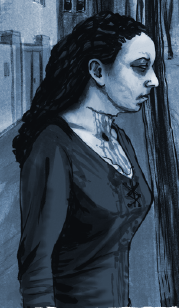
Randos at the bus stop will still tell this lady “Give us a smile, huh?”
Prisoners of the memory of their lives, ghosts don’t tend toward much self-improvement or change, which for eternal shades fixated on the inevitably doomed lives left behind can be a bit of a downer. Being reminded of and remembered for their life keeps a ghost going, but all that stuff is as finitely alive as they proved to be. As the call of the living world fades the call of a different place rises, a place just for ghosts:
THE UNDERWORLD
“Twilight” is a veil between ghosts and the living in the material world, but even it has a geography. Places great in the energies of death, particularly graveyards, sink a little lower, and in their center are Avernian Gates: old, sealed passages into the Underworld. When a ghost’s Anchors have all worn away and they’re out of
This may seem foolish to say, but: the Underworld is underground. Not beneath the soil of the Earth, rather there is no outside to it except back through the Avernian Gates. It’s all the biggest cave system that’s ever been.
Except is it a cave? The Upper Reaches where you arrive first—the book tells us this isn’t even technically “the Underworld”—resemble the subterranean features near to the Gate you came through: sewers, subway tunnels, an unusually long and mazy crypt. You could swear you’re still on the other, warmer side, it’s all so mundane and natural. But it’s so quiet and so still, and no one living is going to hear your screams through that grate. It’s always cold, it’s always damp. There is always water gathering and flowing, down, down, always and forever farther down.
These wending places are also scattered with bizarre detritus, the constantly descending inanimate echoes of just “stuff” without Anchors to tie them to the living world. Sometimes ghosts drawn to the Underworld linger in the Reaches, afraid and not yet forced to go deeper, eking out a middle existence, forming enclaves for protection or raiding, before a Reaper or something even worse comes to steal them down lower.
Eventually through enough tunnels you’ll find yourself at a confluence, where all that water becomes a proper River. Not everyone knows them, but most Rivers have names and they tend to have something to do with what will happen to you if you drink from them. Even if you’re adventurous enough to seek their curse or blessing, these Rivers aren’t always water by the time you’re venturing down deeper, or at least not water you’d want to drink. They can be stale, terrible liquids, swampy flowing bogs filled with strange plants, choking flows of dust, or streams of pus and scabs. Still, some ghosts will risk it and grow heavy with the power of the Underworld in their bellies. That’s where geists come from. They are stronger than ghosts who still hold close to what it was to be alive, but sometimes the pangs of memory stir in them and they make a Bargain with someone to turn them into a Sin-Eater.
The Rivers are the defining geographic feature of the Underworld, and in the small and vast caverns below the Upper Reaches they are the centers of and borders between societies. River Cities dot their banks, where ghosts have found each other and, as they always do, built a reminder of the living world. They find others who shared their religion in life and now keep the faith in death, they find fellow craftsmen to charter guilds that take the plasmic harvests of the Underworld to feed and clothe and house themselves, they form hierarchies to rule over each other. As with everything that lesser ghosts do with themselves, they are always subject to the depredations of older, nastier things from below. River Cities can thrive for centuries before being wiped out by a band of Reapers or the surfacing of a hungry Chthonic monster.
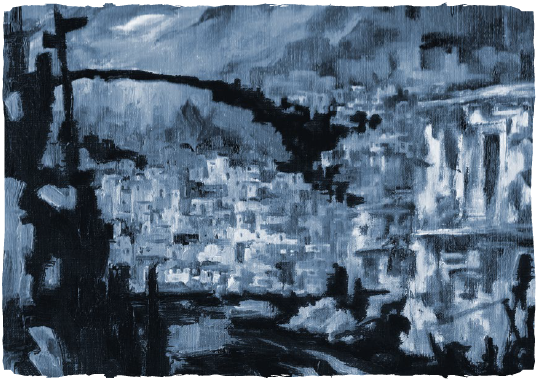
This is Rich Ghost Hell because it’s nothing but favelas.
As prominent and relatively consistent features, the Rivers are also a key method of travel from one part of the Underworld to the other. Yet mastering them is difficult, and travelers will have to rely on the Boatmen, often presenting themselves as the classic Ferryman, but they might instead look like a mudding good ol’ boy or a travel agent. They are shallow, strange creatures always willing to take you downriver, and once we get to the Ocean of Fragments you might have an idea why. Like most of the living legends, they require payment: Coin, plasm, blood, secrets, or other, stranger things. Sin-Eaters can act as their own Boatman, if they know how to navigate the Rivers.
The Rivers, of course, descend still, into the Lower Mysteries, the caverns filled with the Dead Dominions, where Kerberoi and grand Chthonic gods rule. Kerberoi are ancient ghosts powerfully bound to their Dominion, compelled to shape it and police it according to their strange Old Laws. Every Dominion is behind a gate, specified in the book to resemble the Sumerian gate to the underworld, and its guardian is always ready to inform visitors of the Laws before they enter. The higher Dominions, closest to the River Cities, have short lists of simple, usually pretty understandable Old Laws. “Do not stand idle in the market streets” might be the straightforward dictum of an upper Dominion, but get deep enough and you’ll be subject to “Speak only of the past.”
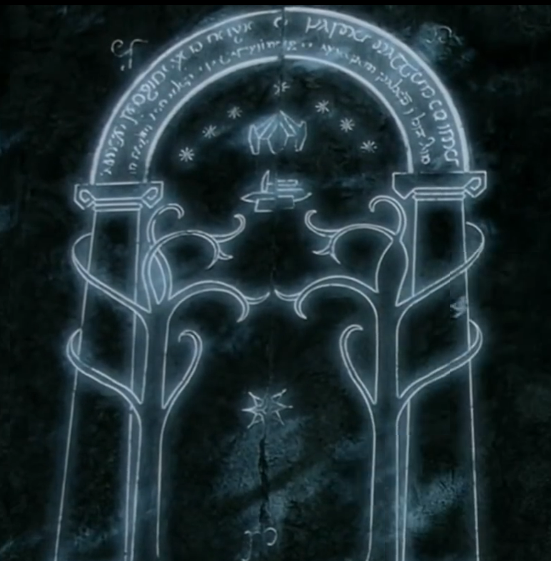
The artist has taken some liberties.
Chthonic entities are the weird natives of the Underworld, unknowable minds slinking through the Underworld in impossible, patchwork charnel bodies, all stinking meat, wrong limbs and snapping insect mandibles. The smaller of them are like fish and toads in the Rivers, eaten by some fisherghosts of the River Cities. The greatest of them are hulking beasts, blindly or uncaringly roaming their territories in search of things to eat, worshipped by cults of deranged ghosts for their obvious power and delectable cast-offs.
Descend past even these depths and you’ll reach what could be considered the end of all things: the Ocean of Fragments. An unknowably vast cavern, you’ll stumble out of a cave onto the shores of an inky black sea stretching endless to an unseeable horizon in the shadows. The Rivers above are a solution that dissolves ghosts bit-by-bit, but here the depthless Ocean drowns and wears away the sparest fragments of living memory, a final forgetting beyond all remembrance. All things in the Underworld descend inevitably here, even Dead Dominions crack and break through the distant cavern roof to crash into the waters below. On the Ocean’s Black Beach lives a strange hermit who strolls the sands looking for discarded memories, at times visited by those most forlorn ghosts building up the courage to wade out and meet their total end.
Only a handful of things seem to survive the wearing waters. There is the Freighter, which in the past has been all kinds of boats but is currently the HMS Titanic, and its forgetful crew that trawls the waters for memorable treasures. Below the Ocean’s waters swims the Leviathan, the awesomely vast Kerberos that enforces the unknowable Old Laws of this last, deepest Dominion.
COMMENTARY
I love it. The Underworld hinted at in other Chronicles books isn’t particularly interesting. What’s here in Geist is, for lack of less ironic words, alive and vibrant. It’s full of stuff to tear down or save, a place where things are happening despite the relatively static nature of ghosts. It’s a place to stick any old bit of mythology you want, but also an alien and insidious realm so you can mix and match and warp it all to your heart’s content. It has a natural and narratively satisfying progression from spooky rat-catcher catacombs to the ageless dark temples of ancient gods. It’s also just written well, excellently conveying the tone of a struggle that is powerful and doomed yet not truly hopeless.
This post covers roughly the first and last main sections of chapter 2, concerning the natures of ghosts and the Underworld. Sandwiched between these sections is stuff about our protagonists, the Sin-Eaters and their Bargains with geists. I’ll get to that in the next post.
INSERT JOKE TITLE ABOUT OLIVER TWIST
You may have noticed I didn’t say anything about the chapter fiction. I’ve decided to skip those for now and cover them all together later. I feel the first chapter fiction is well-written and pretty effective for opening the book and starting the review while the rest of the fiction isn’t strongly tied to each chapter, plus there’s not all that much to the introduction, and also I didn’t think about this until after I made my first post.
Next Up: What if the Ghostbusters were also half ghost?
Chapter 2 Part 2
Original SA post
03 — Geist: the Sin-Eaters 2nd Edition — Chapter 2 Part 2

 Revolutionary Ghost Utena.
Revolutionary Ghost Utena. 

“And, like all of the living, they died.”
—Geist: the Sin-Eaters 2nd Edition
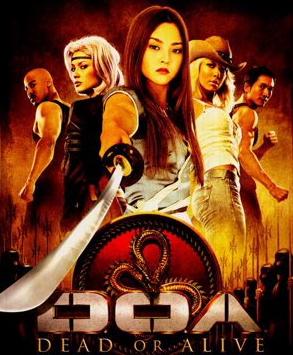
TAKE ON ME
As far as capstones go, death is pretty lacking. Grand or mean, beneficent or avaricious, whether you were a lazy asshole or workaholic activist, at the end of it all waits a moment of ultimate humility and, often, pain. In a split second you’re there then: poof, it’s all over for you.
(Barring, you know, certain circumstances.



 )
)Of course even without the other game lines in the mix, we already know that’s not really true. Geist says that in fact most people can’t help but become ghosts, and it’s in that instant of tearing away, searching, reaching for more that, sometimes, something from the other side reaches back. A geist has shambled up out of the Underworld and, in pursuit of Remembrance for the life they’ve mostly forgotten, someone’s death catches their attention. They intrude. They’re here to offer a hand up, to dust you off and keep you going better than just to be a ghost yourself but to live again. And you’ll owe them. This isn’t an act of altruism, not totally at least. In someone’s most extreme moment, with a barely-glimpsed hell of shades and monsters right around the corner, the geist offers a Bargain. No one knows exactly what happens to would-be ghosts who refuse. They don’t seem to be around to let anyone in on the secret.
For those that accept, they’re Bound, to themselves and to, or by, their geist. Geists are still independent ghosts, with their own unique goals and desires twisted though they are by drinking from the Rivers of the Underworld. They’ve taken a keen interest in their Bound and tend to hang out with them a lot, seeking to draw their attention to things that resonate with them. It’s a Bargain after all, and while the Bound get to keep on living, the geist wants something in return, to unsmooth themselves of the wear the Underworld has done to them, to touch and see the living world again, to remember. And sometimes they’ve got their own business to attend to, leaving the Bound to a new kind of loneliness, an un-dead without even their savior to keep them company.
Bound tend to have some explaining to do, if they don’t just disappear into a new life. “I’m back! Boy that aortic rupture really took it out of me. All better now, though!” doesn’t tend to mollify most people. On top of that, the Bargain tends to require a lot of death resonance to be going around, so pretty often the Bound could be the victim of a serial killer, or on palliative care in a hospice. Someone’s likely to notice that you died and got better. The book doesn’t present a lot of answers here, just problems for your character to figure out.
There’s a side note that Bound used to arise in great waves during deadly catastrophes, but in the modern world the Bargain seems to be struck any old time. Some say that the immense population of humanity and its concomitant mortality guarantees enough death resonance for Bargains any place, any time. Others say “Yeah, because of all that forever war, too.” Still others think that, whether chicken or egg, the Underworld is bloating and getting ready to devour the world of the living. Fun stuff.
This is why, while there’s a lot of shared and old tradition among the Bound, it’s scattered and discontiguous. There have definitely been whole societies of Bound, but they rose and fell with the deadlier times. Now that
 is everywhere, for whatever reason, and also thanks to things like telephones and the internet and internet-telephones, things are more connected than ever. Unfortunately, smartphones and the surveillance state also make it harder to keep to the shadows while you do the important work, whatever that means to you.
is everywhere, for whatever reason, and also thanks to things like telephones and the internet and internet-telephones, things are more connected than ever. Unfortunately, smartphones and the surveillance state also make it harder to keep to the shadows while you do the important work, whatever that means to you.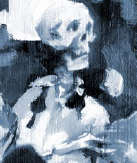
”Hey, how ya doin’?”
TAKE ME ON
Being Bound isn’t the same as being a Sin-Eater. You can make the Bargain and hang with your new geist pal, but that doesn’t automatically make you the protagonist of Geist. Everyone who sees the other side knows that something is seriously wrong with the afterlife, but Sin-Eaters are the Bound who decide to do something about it. Of course, what’s a revolution without friends? That’s where krewes come in.
Whatever your hot takes in life, becoming Bound puts you squarely in a supernatural environment. You see the ghosts that are everywhere and the rotting Underworld waiting for them to fall inside, and your humanity or instinct to tinker or rebel compels you to figure out how to fix it. Being as magic and the afterlife are clearly real at this point, it looks like you’re going to have to resort to religion.
That’s what a krewe is, a little religion all for you (and your friends). There have been countless krewes over the course of human history, some of them long-lasting, some of them just tiny cults that burn out as fast as their members. They take bits and pieces from “normal” religion, stuff that seemed to work even for people who haven’t been to ghostland and back, and they also pass on their own traditions, or invent entirely new ones. They take advice from other krewes, from mainstream denominations, from little out-of-the-way heresies, and even from ghosts. A grand game of telephone for the hows, whys and wherefores of dead spells.
Geist: the Sin-Eaters 2nd Edition posted:
Modern krewes take all those forms and more. A mahjong group that meets weekly. A cell of DEA agents in a bust that went sideways. A fantasy football league. An after-work jazz band that always seems to meet but has never played a venue. These days, krewes can even be scattered around the world and connected with technology. Some even practice their faith openly, either as a fringe sect of a larger church, a “revival” of an old religion, or an entirely new doctrine. Even in countries where religious freedom is nominally the law of the land, though, faiths outside the mainstream (or worse, that seem “foreign” to the people in power) are often targeted for harassment, so openly religious krewes have to tread carefully.
We’ll see later in the book that krewes are comprised of more than Sin-Eaters and their geists. They include living devotees, “sensitive” or not to the weird shit Bound get up to, as well as friendly ghosts. In fact, the whole krewe is an important part of the game, with its own sub-systems. It really is a religion, with trappings and rituals to help Sin-Eaters do their jobs, as well as influence in the living world to uncover hauntings or canvas neighborhoods for that city councilwoman you like. And, of course, a krewe lends itself to more private character moments, and troupe play!
While Sin-Eaters’ principal activity in a game will presumably be outward-focused, starting cults or soothing and banishing angry ghosts or fighting evil ghost-kings, there will always be a lurking element of understanding your connection to your geist and just what their whole deal is. When a ghost drinks from the Rivers and swells with power, they begin to shed or bury a lot of their humanity. As a Sin-Eater’s and geist’s relationship—Synergy—grows, this proves to be just as powerful, or even more so, than the liquid horror of the Underworld. This can lead to one of the three main end-game scenarios of being a Sin-Eater, to unlock both the memory and power of your geist through Catharsis. This ultimate understanding between Bound and geist tends to be the end for a character both narratively and physically; they’ve resolved the conflicts that kept both of them here and are ready to move on to whatever comes after. There are more details and expanded options concerning this and other end-game scenarios later in the book.
Another option for the end-game, which is not mutually exclusive to Catharsis, is Catabasis: Descending into the Underworld to engage in ritual challenge against its dark gods, overthrowing them and building a better afterlife for everyone. It’s been attempted more than once in the past, and the ruins and corpses left behind are proof it didn’t work. That’s why it’ll be even cooler when you manage it yourself!
The least savory end-game option the book presents us with is to pursue the opposite of Synergy: Tyranny, and its end in Cabeiros. The Bound bullies and masters their geist, turning them into a slave. They need to find out at least a little about them in order to hurt them best, but once they have their Touchstone, they can force-feed them on the Rivers of the Underworld, to grow fat with power, then destroy the Touchstone and crack the geist’s plasm open like a bone to suck out the delicious, powerful marrow.
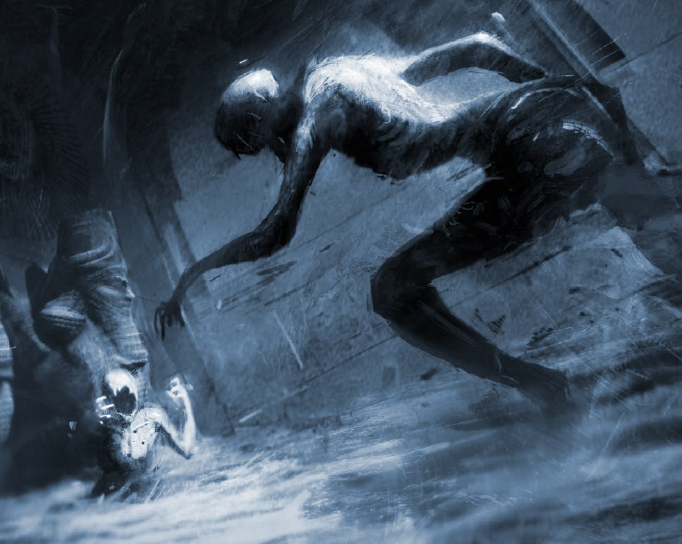
”Mom said it’s my turn on the X-Box!”
COMMENTARY
As you might guess from how I’ve structured my review, I’m not a big fan of how this book is laid out. (A sin to lay at the feet of all the Chronicles games, to greater and lesser degrees.) This post covers the middle part of the second chapter. Nevertheless, my most substantive complaint is definitely that this section is a little too poetic and light. There’s a lot of tone-setting without enough detail to really get across just what you’ll be doing playing a Sin-Eater. There is a fair amount of redundancy about loss and finding meaning throughout the bulk of this chapter, and even without an expanded word count I think the sections on Sin-Eaters, the Bargain and “the Carnival” (Sin-Eater society/religion) could’ve acted as a clearer introduction to the structure of the game.
But! To fresh eyes this grabbed me, and months later I still like it. You aren’t just a revolutionary of circumstance, driven to riot and overthrow simply because you’ve been left no other choice. In fact, Bound are fairly privileged in the hierarchy of the dead. The game, like all the others, has its moral mechanics to it, but fundamentally the driving force of why to play is simply that you see that something is seriously wrong with the world and want to fix it. There’s no -2 dice penalty for not agitating for change enough, because this game: a) can’t make you play a revolutionary if you don’t want to; b) can let you just have fun ghost adventures if you want to, anyway.
This may seem obvious, but many Chronicles games have serious moral dimensions to their mechanics that are meant to drive the main, intended conflict of the game. Of course, Geist does have some of that in your relationship with your geist, but as far as ghostly revolution is concerned the book is only here to encourage you to play that way, not to make it happen for you. I appreciate that, and it’s a kind of restraint that some of the other game lines could’ve benefited from to varying degrees.
Next Up: Let’s get the chapter fiction out of the way because it’s already written up and the character creation stuff is going to need more time.
Chapter Fictions
Original SA post
04 — Geist: the Sin-Eaters 2nd Edition — Chapter Fictions

 QUIP.
QUIP. 

”I’m under the floorboards.”
—Geist 2nd Edition character Oliver LaVoie
As I said in a previous post, since we’re skipping around a bit, here’s where I’ll tackle the opening chapter fictions. This will cover the fiction openers for the rest of the book. But not in order, and you’ll see why.
Chapter 1’s opening fiction introduces us to an idea of Sin-Eaters’ day-to-day. Leah, High Priestess of the Church of the Brighter Morning, is busying herself fixing up her house while her geist, the Abandoned One, lurks. We get a brief flash of memory of her drowning, and the Abandoned One coming to make the Bargain with her. He alerts her that someone’s coming to the door, a krewemate named Mark and his geist the Open-Throated Saint. The Sin-Eaters make some awkward small-talk, while their geists sort of square off like uncomfortable pets before Leah puts a stop to it. They start over with more formal, cult-y greetings, and Mark presents her with the case from the prologue fiction, asking her to take care of it. Mention is made of their fallen comrade Aiden, his recent no-take-backs death weighing on them and driving them apart. Another krewemate, Oumil, isn’t available because he’s in the Underworld somewhere, and Mark has to go “make peace with Fifth Street.” Leah doesn’t want to do it but her geist does, so she acquiesces. This fiction honestly isn’t very interesting narratively, but it does help set expectations for how Sin-Eaters and their geists interact.
Chapter 2’s opening fiction tells the story of how the family from the introductory fiction, the Patels (Hari and his daughters Jade and Trisha) have been persuaded by a family friend to ask for help from the High Priestess of the Church of the Brighter Morning, Leah. The Priestess gathers her celebrants and uses incense, booze and a stick to manifest the ectoplasm that is invisibly slathered all over everything in the house. She uses this to draw forth Oliver and promises to help him and his family quiet their dead hearts and find their eternal rest. Unfortunately some external force goes all poltergeist and riles up Oliver, shit goes sideways kaio-ken x20, and the house cracks like an egg before falling into the void. I’ll take a moment here to say that the previous two chapter fictions’ dialogue was…alright. This one’s is not. Narratively this continuation is great, but there’s a lot more dialogue and it’s a bit mediocre.
Chapter 4’s opening fiction picks up in a Dead Dominion, as Jade and Trish scramble to recover their father from the rubble of the house, while Leah and her geist confront the Reaper that dragged them down here. Reapers are a powerful kind of ghost that use Deathmasks to venture into the world of the living and retrieve lingering ghosts into the Underworld. The Reaper starts off as a ball of chains made out of bones, but uses its mask to take a human form. It tempts Oliver with promises of reuniting with his family, but the Patel sisters unearth their sorely injured father and their plight moves him to help them return to the world of flesh. There’s a bit of a scuffle—Oliver tries and fails to punch the Reaper—then Leah diverts the Reaper by forcing her to replay her death on loop while the Priestess, Oliver and the Patels book it for a nearby River which they can follow back to the living world. There is a fair amount of dialogue in this one, too, but it’s mostly short and punchy.
Chapter 3’s opening fiction is an interlude, where Leah’s krewemate Mark visits an apartment building controlled by a rival krewe: the Fifth Street Titans. He’s there to broker peace between their warring groups. His geist the Saint growls at things and he plays with some magical dice from a cheating dead gambler that are an opening peace offering for negotiations. Right as he’s sitting down with the Titan’s Golden Tycoon to talk terms, he gets a 911 text from the krewe. The Tycoon warns him that shit’s about to get real if he walks out now, and then Mark proves he’s as badass as his name and does indeed leave the end hardly anything happened. I guess the dice were cool: they’re a pair of normal looking six-siders but the Tycoon asks the dice if they’re the real deal and they roll themselves to show 8 and 10. I give this fiction a “meh” out of 10.
Chapter 6’s opening fiction is the second and last interlude. Mark arrives at the crater where the Patels’ house used to be, and the battered krewe celebrants, who escaped the collapse, give him the low-down. He makes a little pick-me-up speech, and then they all pile into his car to go to the hospital. They hear sirens approaching, one of the celebrants worries what they’ll tell the authorities, and then Mark takes a badass stance and fade to black. This is the most filler-feeling of the fictions. I don’t hate it, but I am glad it’s short.
Chapter 5’s opening fiction finds that Leah, Oliver and the Patels are fleeing down a tunnel searching for a River to navigate by. Some bickering breaks out, but they’re interrupted by Jade’s cell phone receiving a text. Leah uses the phone to call Mark. They have a very brief exchange before being interrupted by Hari Patel collapsing and succumbing to his wounds. Leah tries to enact a rite to ensure he doesn’t leave a ghost, but Jade is furiously playing the blame-game. Hari’s ghost leaves his body and is immediately lured away, trailed by his daughters. Leah informs Mark she’ll have to follow them into the Dead Dominion they seem to be wandering into, then hangs up the phone.
Chapter 7’s opening fiction follows Leah as she creeps into the weird village Dominion the others wandered into. There are insensate ghosts milling about, and when one breaks off to enter an unearthed bomb shelter in the middle of the village, she slips in behind him. The summoned ghost completes a phalanx in the middle of the room; near the front of the formation Jade is suffering some seriously inky, full-body varicose veins as she futilely shakes her father’s ghost to try to get him to leave. A column of wings appears out of the shadows, presumably the Kerberoi of the Dominion, unfolding to reveal a funky chunk of heart-shaped meat in its center that scolds the interlopers before the wings enfold Jade before flinging her viscera around the room. The Cage of Wings approaches Oliver and Trisha, who are cowering behind some boxes. Leah and the Abandoned One argue about what to do, but unlock some of her geist’s memories: he was a little boy, fleeing a war, dying in the cold, snowy forest. Leah acquires new ability: Rock-fist. Shit’s getting real, Mark and Oumil show up, Oliver makes a valiant sacrifice so everyone else can get out, and they make their way up the River to the sewers and then to daylight.
The final opening fiction, before the appendices, is an epilogue. It has been a couple weeks since the escape from the Underworld, and Trisha Patel’s deadened senses are finally returning. Her mother found her crying in the shower, presumably in grief, but she was actually crying in relief that she could finally feel the heat of the water again. The Underworld will fuck up a mortal, yo. She can see ghosts now. She makes her way to the Church of the Brighter Morning to talk with them about what happened, and they reassure her they strive to free everyone from the bondage of life-after-death, including her father, who is still trapped down there. Which is why she’ll be joining the Church. The End.
All in all, a good narrative marred by some clunky dialogue and the interludes, which feel like expansions on stuff that should’ve just been off-hand mentions if they came up at all.
Next Up: The unbearable lightness of being (character creation et al).
Chapters 1, 3 & 4 Part 1
Original SA post
05 — Geist: the Sin-Eaters 2nd Edition — Chapters 1, 3 & 4 Part 1

 Trait me like garbage. Really nice garbage.
Trait me like garbage. Really nice garbage. 

“If you are silent about your pain, they’ll kill you and say you enjoyed it.”
—Zora Neale Hurston
Geist is a game about people and all the complexities that drive them to act, particularly within a world full of impersonal injustice that oppresses everyone with a sense of casual utility. What intersection of self-interest and empathy is necessary to turn someone into a revolutionary? Let’s boil all that down into a handful of phrases and a series of numbers.
Welcome to character creation!

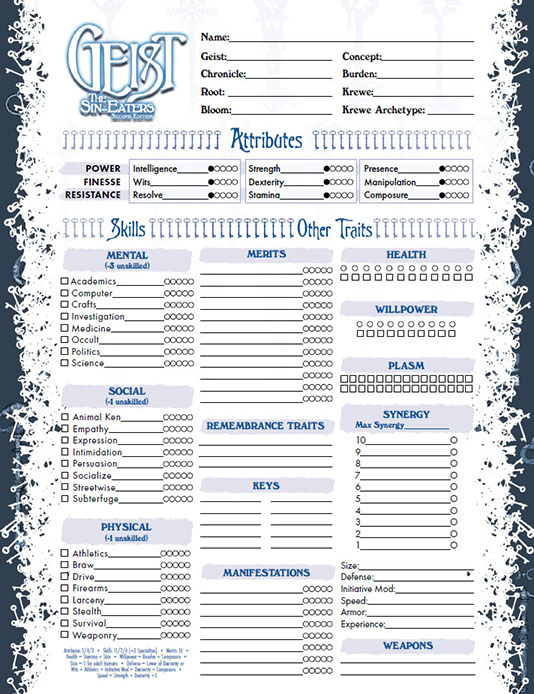
YER TRAITS ARE BASIC
Like most games you’ll want to have a rough concept in mind before beginning, which will be better informed by content we’ll cover in the next post. Advice peculiar to Geist is to think about your character from the two distinct perspectives of what they were like in life and what they are like in “death.” Did their death transform them totally, or did it merely bring new focus to what they’ll keep doing with themselves? Have they taken the chance to continue or even improve their old life, or abandoned it completely to begin anew?
The first traits you’re asked to define are Aspirations, short phrases that outline character arcs you’d like to see your character go through. These aren’t necessarily what your character aspires to accomplish; they can be things that they’d really rather not happen. It can be the character’s personal goals or simply what you, the player, want to see happen to them. Each player character should have one long-term Aspiration and two Short-term Aspirations. You’re expected to make significant headway toward an Aspiration about once per session, which will earn you a Beat (which is one-fifth of an Experience).
You don’t have to agonize over them, or even nail them down before the start of the game. They’re meant to change over time as you progress through and resolve them, and you can even just get rid of them and choose new ones if they don’t work out.
After that, you assign your Attributes, Skills and Specialties. The former two are fixed traits rated by one to five dots, while the latter are specific areas of expertise under a Skill. For most actions you’ll combine an Attribute and Skill, rolling that many ten-sided dice. Specialties add +1 die when they apply. Every die showing 8+ is “a success” and, most of the time, you can re-roll 10’s to try for more successes. That’s known as “10-again”, and other dice tricks exist such as 9-again, 8-again, or rote where you re-roll every non-success die once.
You just need one success to accomplish a task, but if you get five or more that’s an “exceptional success.” If you attempt something and your dice pool is reduced to 0 or less, you’ll roll a “chance die” where only a 10 is a success and you don’t re-roll for a success. Rolling 1 on a chance die, or voluntarily making a regular failure worse in exchange for earning a Beat, is a “dramatic failure” that can really fuck you up.
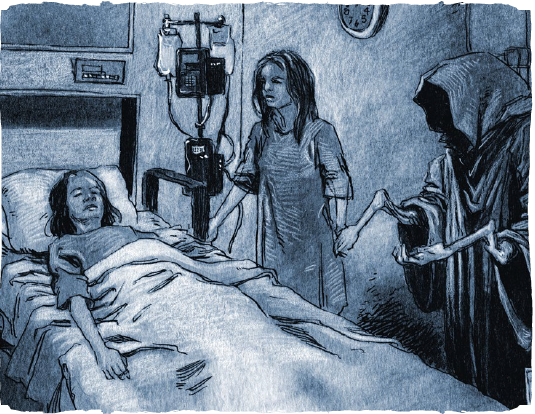
”Oh my god, my twin is also in this hospital!”
SIN-EATER TEMPLATE
Now it’s time to add the magic. Choose your Burden, the principal circumstance of your death that attracted your geist, made you accept the Bargain and informs what you’re going to do with your second chance. You get an extra Aspiration that ties your life, death and Burden all together. Unlike a regular Aspiration, resolving your Burden Aspiration grants you a dot of Synergy (your power stat) and increases your geist’s Rank by 1 (your geist’s power stat). Each Burden is also associated with three Affinity Haunts, which are your magic power sets that a given Burden gets an Experience cost discount on. Finally, you should choose an Innate Key associated with your Burden and death, which among its powers allows you to boost your Attributes, regain Plasm (magic points) and open Avernian Gates. You’ll gain another Innate Key from your geist, and can access more Keys through Mementos or by eating other geists.
Oh, and this isn’t mentioned anywhere in the character creation section, but all Sin-Eaters gain free access to a handful of Ceremonies: Bestow Regalia, Krewe Binding, Speaker for the Dead, and Pass On. Ceremonies are rituals for dealing with the dead that are used to define the specific faith of a krewe, but can also be known and practiced by individuals. They aren’t even necessarily overt magic, as many of them are performed regularly by mundane religious organizations. You can learn more Ceremonies as Merits, or you can use the Ceremonies of your krewe as long as your initiation rank equals their rating.
We’ll get into more detail on Burdens, Haunts, Keys and Ceremonies in later posts.
You have one dot of Synergy, your power stat that determines how many magic points you can hold as well as how many points you can spend in a turn. It also tends to figure into dice pools for magic powers and similar actions. Really high Synergy also allows you to increase Attributes and Skills above five dots. Many of the things ghosts do relate to their Rank, and Sin-Eaters have an effective Rank equal to the lower of your Synergy or your geist’s actual Rank. Your Synergy reflects how closely you are bonded with your geist, and that in turn helps determine what happens when your geist wants you do something that you won’t do. I’ll cover that in more detail when we get to geist creation.
Like most Chronicles games you can “spend” or lose dots of your power stat in order to achieve certain effects. The most typical for these games, creating magic items, is here, but you also lose Synergy when you eat other ghosts to stock up on Plasm, when you drink from the Rivers of the Underworld, or when you die and your geist has to bring you back to life again. If you wind up at Synergy 0, you lose most of your cool powers and can, you know, die for reals. You can’t buy yourself back up from Synergy 0 with Experiences. You’ll have to either complete a Remembrance (we’ll look at those under geist creation) or, if you’ve previously reached Synergy 3 and gotten your geist’s Remembrance Touchstone (also more below) you can smash it and switch to Tyranny, gaining one dot in that trait, where you’re less like a partner and more like a master to your geist.
Plasm are, as I’ve said before, your magic points. It’s also the “physical” substance of the world of the dead, so, uh. You’re filled with ghostflesh! It can appear in the material world for a number of reasons, perhaps most often when a ghost Manifests in various ways. It typically appears as a milky-white goo, though it can also be thicker and comes in all kinds of gross colors associated with death and rot. Sin-Eaters can consume it to add it to their pool of power points, but in this case “consume” doesn’t just mean “eat” but can include smoking or injecting it. Consuming Plasm is subject to the same per-turn limit as spending it. Consuming Plasm in a situation resonant with a Sin-Eater’s death grants a couple of bonus points that can take you over your maximum pool, though any excess disappears at the end of the scene. Plasm left behind by a ghost who “moves on” totally refills your pool.
Obviously, you can spend Plasm to produce cool effects, often in the course of using Haunts. Innate powers for every Bound include accessing the Remembrance Traits of your geist, or coating something in it to make the subject “Open” to ghostly powers. One of a Sin-Eater’s beefiest powers is healing with Plasm, because they can downgrade any type of damage one step for one Plasm, or shed Tilts from physical harm for more, reflexively and ignoring their per-turn limit. While this can get expensive, it’s readily available to all Bound and is only stopped by wounds inflicted by their geist’s Bane.
Unlike normal people’s Virtue and Vice, you have a Root and a Bloom. These are the main ways you’re likely to regain Willpower points, an expendable source of hero points for getting some bonus dice on an action or fueling strong magic. Examples include Advocate, Antihero, Enabler, Pollyanna and Servant, but you’re encouraged to come up with your own.
Root Basics posted:
- Quick and Easy: Once per scene, when your Root leads you to give precedence to the dead or your own death, regain 1 Willpower.
- Grand Gestures: Once per story, when your Root leads you to risk your life or your status in the living world for the dead, or to protect the dead from the living at great risk or cost to yourself, regain all spent Willpower.
Bloom Basics posted:
- Quick and Easy: Once per scene, when your Bloom leads you to ignore the dead or your own death to tend to the living, regain 1 Willpower.
- Grand Gestures: Once per story, when your Bloom leads you to risk your life or your status among the dead to tend to the living, or to protect the dead from the living at great risk or cost to yourself, regain all spent Willpower.
I won’t wait for the commentary section to note that, while this is in some ways more generous than typical Virtue and Vice, it seems a little too harsh restricting full Willpower recovery to once per story (multiple game sessions defined by a story arc) instead of once per chapter (a single game session). I suspect this may be a mistake.
You also have Touchstones, one based on your Burden to start out with, then at Synergy 3 one tied to your geist’s Remembrance, and finally at Synergy 6 one that represents what you desire to change about the Underworld. When you’re making an effort to pursue and protect a Touchstone you get +2 Synergy dots; when you’re pursuing two or more Touchstones, you get +3 dots. These dots don’t count towards how many Touchstones you can have or increase your traits past the normal cap, but otherwise act as normal Synergy dots, increasing your Plasm pool and adding to relevant dice pools. If you resolve a Touchstone, your geist gains 1 Rank.
Like your Root and Bloom you should feel free to come up with your own, but the book provides some examples. Maybe you keep the community center going, or you’ve become an alcoholic like your geist was in life, or perhaps you’ve developed a relationship with your neighbor after you left your old life behind.
FINISH HIM
Apart from figuring out derived traits like Health or Speed, your last step is figuring out your Merits. Merits are a catch-all for stuff like a character’s social capital, liquid finances, or being very attractive looking. You also buy individual access to Ceremonies as if they were Merits. On top of the 10 dots of Merits you get, Sin-Eaters start with two Merits for free: Medium and Tolerance for Biology. Medium is what “normal” people use to contact the dead or other kinds of spirits, which for the purposes of simple communication tends to be inferior to a Sin-Eater’s inherent ability to see and hear immaterial ghosts. However, it can also be used to “Open” an area, making it easier for ghosts to use their powers there. Tolerance for Biology just means you’re not particularly phased by gross-out stuff like blood and guts. Sin-Eaters also get a free dot of Mystery Cult Initiation (see below) as long as they don’t opt-out of starting with a krewe.
Geist has a pretty brief list of Merits compared to most of the other games, but this isn’t necessarily a bad thing. There’s still a good amount here, and you can look to other books if you really needed five more fighting styles. Geist also introduces a more robust set of keywords for Merits. Where previously there was pretty much just “Style” to denote a fighting style (itself a definition stretched to breaking in some game lines), here we’ve got “Shared” which formalizes a piecemeal rule from previous books allowing player characters to pool Merit dots for a mutual benefit like a hideout, or Krewe and Krewe-only which are Merits that can (or can only) be bought by your death cult. Some Merits also have special extra effects depending on your Burden.
Here are some highlights:
- Architect: You get a pool of extra dice for extended actions to build things, and any given roll that benefits also gets 8-again. If your Burden is Abiding, your bonus dice also count as part of your “base” pool for determining how many rolls you get to make before the project fails.
- Cenote: You’ve got easy access to a spooky place where you can harvest a regular source of Plasm.
- Dread Geist: Your geist is Rank 4 instead of Rank 3. I’m kind of iffy on how worth it this is considering how many other, in-the-course-of-play parts of the game involve increasing your geist’s Rank.
- Grave Goods: You have a collection of ghostly, otherwise-mundane items. Sin-Eaters and ghosts can use them for their normal functions, including stuff like connecting to phone networks or the internet, even though they’re ephemeral and invisible to normal people. You can eat these items for Plasm. Once per chapter, Sin-Eaters with the Hungry Burden regain all their Willpower when they pull out a ghostly frying pan!
- Manic States: I am not a fan of this Merit. It’s a little too vague to totally nail down, but it seems to be trying to model a semi-real manic-depressive cycle, it’s not magical, so it’s basically “mental illness super-powers” which I’m not a fan of. I would’ve preferred something more focused on a sort of religious ecstasy, especially considering how krewes are literal religions.
- Memento: The magic item type for Sin-Eaters, they’re physical objects with a ghostly Twilight presence. This Merit costs a flat three dots per Memento, and they are all relatively mundane items but with some weird spooky trick: an oxygen tank that suffocates you but gives you crazy hallucinations, a phone that works anywhere as long as it’s underwater, or a hearse that can pass through any Avernian Gate as long as it’s going at top speed. All Mementos that can be worn as clothing count as armor. If your Plasm is getting low you can refill it by feeding a Memento to your geist.
Mementos are impossible to harm or destroy by accident, and they’re extra tough against deliberate harm. Most Mementos are created in the presence of some major death resonance like a grisly murder, which gives it an appropriate Key that a Sin-Eater can use as long as they wield the object. Some Mementos are weirder things that came from the Underworld into the land of the living. Sin-Eaters can also deliberately create a Memento at the cost of a dot of Synergy. Sin-Eaters and ghosts inherently recognize a Memento for what it is and what its Key is.
There is a sidebar about rumored “Greater Mementos”, like a Roman trireme that never takes more than a day to go from one port to another in the Mediterranean, or a watch that makes you ageless. There are no specifics or mechanics for these though. I suspect we’ll see more in the companion book stretch goal from the Kickstarter.
- Mystery Cult Initiation: You’re part of a cult! This grants bonus Skill dots and Specialties at lower ranks, and bonus Merits at higher ranks, based on the particulars of your cult. Krewes are cults and your membership in them in represented with this Merit, which also grants you access to the krewe's Ceremonies with a dot rating equal to or less than your initiation rating.
- Phantom Limb: You lost a body part but its ghost is still attached to you! This doesn’t do a ton to help you out in normal material reality, but it has various effects interacting with ghosts and Twilight, and when you enter the Underworld it’s like you never lost the body part. My favorite is “leg” because you can “lockpick” Avernian Gates by kicking them open.
- Retribution: This is a “fighting style” where you get bonuses when you’re out for vengeance, from tracking down a villain to emptying your clip at them. If your Burden is Vengeful you get 8-again on any rolls using these abilities.
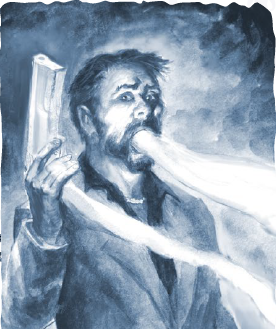
If your gun is too stringy, try adding lemon juice.
COMMENTARY
While to some degree we all come here for the numberwang, it’s hard to be as effusive as I’d like to be about a bunch of basic trait explanations and charts. Of course, I have a variety of
 Opinions
Opinions  about how layout, organization and rule-making should be done, but most of these concern what’s basically the trade dress of Chronicles at this point, or even “just how it is” for traditional RPGs in general. Let’s leave that boring, sadsack shit aside.
about how layout, organization and rule-making should be done, but most of these concern what’s basically the trade dress of Chronicles at this point, or even “just how it is” for traditional RPGs in general. Let’s leave that boring, sadsack shit aside.Geist does a pretty good job of tying your character into the basic premise of the game. Root, Bloom and Touchstones are good motivators for being a mediator between the living and dead worlds. The toys that really sell the Sin-Eater experience are in later posts, but the fundamentals here are a good start. One specific thing I’ll call out for praise is breaking out rules into summary bullet points at the end of the sections about them. Geist is the first Chronicles game to do this, and hopefully not the last. It’s a good move, especially for games with this level of interconnected complexity.
Next Up: Let’s talk about geists, bay-bee, let’s talk about krewes and XP.
Character Creation, Part 2: Geists, Krewes & Advancement
Original SA post
06 — Geist: the Sin-Eaters 2nd Edition — Character Creation, Part 2: Geists, Krewes & Advancement

 Mysterious and spooky.
Mysterious and spooky. 

FRIENDLY GHOST CREATION
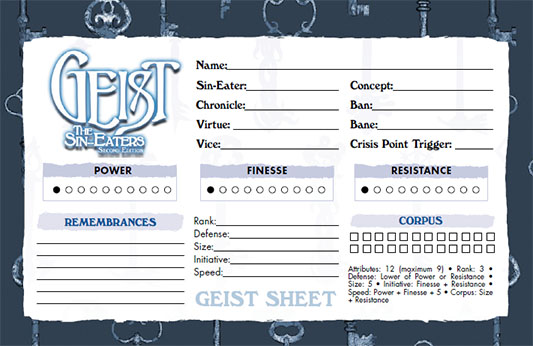
Ugh, I made an entire character, more or less. And now I have to make another one? Who designed this, the ghost of Reuben Garrett Lucius Goldberg? Fine.
As with a principal, Sin-Eater character, creating a geist is all bound up with the core concept of how the character died. This determines the Key that resonates with them, which acts as an additional Innate Key for the Sin-Eater and also a power the geist can use in the rare times it manifests physically. You might have only the vaguest notion or a detailed idea, but geists are archetypal creatures. They’ve gorged on the power of the Underworld’s Rivers, burying their past and humanity. Yet there’s enough left there for the Sin-Eater’s death to draw them in somehow, to tantalize them with the possibility of reconnecting with their own lost life. Geists have forgotten so much of themselves, they don’t even have names, they have titles evocative of their nature or urban legends that they’re connected to. Geists are so deformed from their time in the Underworld that those who might recognize them from their former life struggle do so (a Resolve + Composure roll), while in social situations they are largely only interested in and affected by fear (non-intimidation/fear Social rolls are a chance die, coming and going).
Geists, remnants of some poor human, have a Virtue and a Vice, which for all ghosts are reversed in effect: they regain all Willpower when indulging their Vice, and only one Willpower when struggling to maintain or protect their Virtue. There are a number of traits that geists lose and share with their Bound when the Bargain is struck, and Willpower is one of them, which is a little bit of a problem because just how that works is unclear. Geists suffer a serious lack of self-agency, which makes it very hard for their Virtue and Vice to come up due to their own actions. But if the Sin-Eater has “access” to them, that seems like something the book would, uh, mention out loud.
Like every other ephemeral entity, geists have a Ban and a Bane. A Ban is some behavioral restriction, like being unable to cross water or having to flee from freshly broken sticks arranged a certain way. A Bane is something of such metaphysical disharmony that it is uncomfortable to be around, harmful to touch and can cause serious damage when used as a weapon, like the murder weapon used to kill a ghost’s living self.
Every geist has a starting Remembrance, a basic jumble of sensations that are clues for the Bound and their geist to find out more about the geist’s past. Following these clues over the course of a story leads to another Remembrance, drawing up more detail from the geist’s past and leading to another, final Remembrance that reveals the circumstances of the geist’s death and what originally kept them going in the afterlife. While the first Remembrance is mostly up to the Sin-Eater’s player, it’s supposed to be a mysterious ghost story so it’s encouraged that the subsequent Remembrances primarily be devised by the Storyteller. Each time a Remembrance is resolved the Sin-Eater gains one dot of Synergy and the geist gains one Rank (up to a maximum of 5).
Connected to a geist’s Remembrances are Remembrance Traits. You start with one and gain another one with each subsequent Remembrance resolved. These are Skills or Merits with a value of three dots or less that the Sin-Eater can spend Plasm per-dot to gain access to for a scene. This can take the form of sharing sense-memories or the geist just giving really good advice. Dots gained from a Remembrance Trait are cumulative with your own and can exceed normal trait maximums, which is usually only relevant to Skills. After the scene you suffer “echoes”, weird memories of stuff you should be able to do but can’t because that’s someone else’s history, imposing a -1 die penalty on further uses of a Remembrance Trait until you get an exceptional success or buy a new dot in it.
Also based on their Remembrances are a geist’s Crisis Triggers, circumstances that dredge up their mortal trauma. They start with a Hazy Trigger, gaining a Vague Trigger with their second Remembrance and a Specific Trigger with their final Remembrance. You’re encouraged to come up with your own, but there are some examples provided such as Jealousy (Hazy: neglecting pursuing Remembrance in favor of the living; Vague: try to prevent the geist from flipping out to protect a loved one; Specific: actively work to find a way to sever the Bargain). There is also a set of Universal Triggers that apply to all geists, like when the Bound suffers harm from the geist’s Bane or ignores the presence of the geist’s Ban.
When a Crisis Trigger arises a Sin-Eater can intercede in order to calm down the geist. This is, as far as it goes, the “morality stat” for Geist. If the Bound chooses to intercede they roll a dice pool based on their relationship with the geist, which is strictly tied to their current Synergy. At one dot the relationship is “Coercive” and the roll is made with a chance die. At 2-4 dots the relationship is “Positional” and the dice pool is equal to Synergy. At 5-7 dots the relationship is “Sympathetic” and you add the lower of your Manipulation or Presence Attributes to your Synergy, while at 8+ dots it’s “Empathetic” and you add the higher of those two Attributes instead. Failure on these rolls doesn’t guarantee your geist flips out, but the worse your failure the harder and more costly it is to rein them in. To avert a crisis after a dramatic failure costs a dot of Synergy, and on top of that the next intercession is resolved as if the relationship was worse by one step.
If a geist facing crisis is not soothed, either because the Bound chooses not to or fails, then the geist is Unleashed, becoming physically manifested and reacting in one of four ways: Defending the Sin-Eater, grabbing the Sin-Eater and running away, lashing out violently at both the Trigger and anything that gets in the way of doing so, or becoming fixated on the Trigger (and attacking anyone that tries to distract the geist). If the Trigger is or comes from a human, the latter response freaks them the hell out in turn, which is a breaking point (basically, psychic stress). Though, really, any encounter with an Unleashed geist is likely to constitute a breaking point for normal humans.
Sin-Eaters can voluntarily Unleash their geist once per game session.
As ephemeral entities, geists are numerically pretty beefy, but putting this advantage to good use leaves the Bound in a perilous position. Geists in a Bargain don’t have their own Willpower or Essence pool like a regular ghost. They share the Sin-Eater’s Willpower, and while the geist is Unleashed, they take control of the Plasm pool and the Sin-Eater can’t spend it. If the geist is taken down by lethal or aggravated damage, neither of them “die” but all that delicious Plasm is gone.
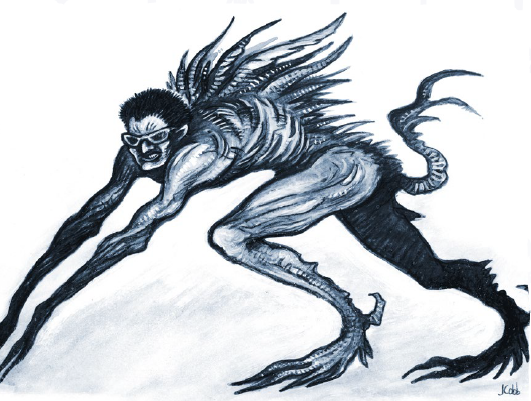
Deal with iaaAAAUUUGHHH!!

Geists, like all ghosts and other ephemeral entities, have a simplified set of Attributes, seen above, and they don’t possess Skills. They get a big pile of dots to distribute among their Attributes, with a pretty high cap based on Rank (9 max at Rank 3, 12 at Rank 4, etc.). “Normal” ghosts have Numina—discrete powers like “energy blast” or “cause hallucinations”—and one or more Influences that are distantly similar to Mage’s magic, being a generalized scale of power over purviews based on their death like “my Anchors”, “stabbings” or “car crashes.”
Geists don’t have Numina or normal ghost Influences, or even really any powers when they’re not Unleashed. In the event that they are Unleashed, a geist has access to their Bound’s Haunts, and the geist’s Key acts as an Influence with dots equal to their Rank.
LET’S YOU AND HIM FIGHT
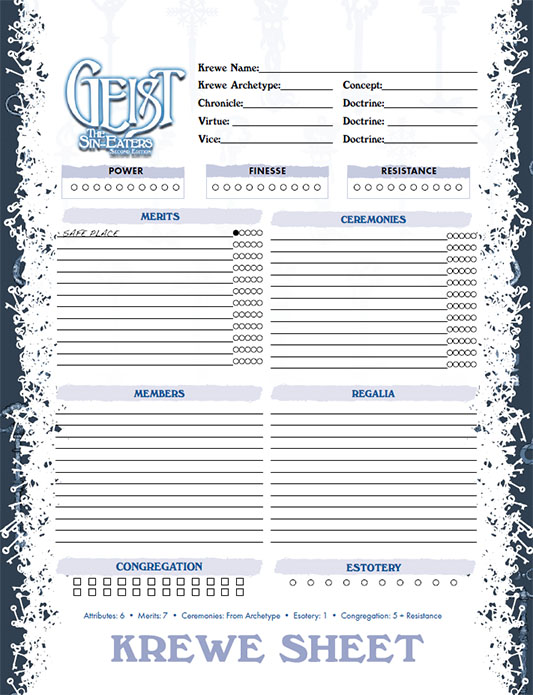
Regardless of the specific attitudes of a character—or perhaps instead it’s a key conflict for you—religion and religious ritual is a demonstrated practical reality in Geist. Just, you know, not quite the ones anyone was ready for in life. Any given group of Sin-Eaters tend to form a religion called a krewe, which in addition to the Bound includes both living and dead celebrants. Here’s where we found our ancestor cult/communist afterlife revolution. During this process is also a good time to “introduce” the main characters to each other, form connections, explain why they’re founding a religion in the first place (or why they’re joining an existing one). Then you’ll create the supporting cast, each of which may “belong” to the player who creates them or may be used as-needed by anyone. Troupe play is encouraged!
The guidelines for creating ghost celebrants amount to “go through the steps to create an entire ghost character”, and you aren’t expected to come up with a ghost for every player. For living celebrants, you’re mercifully given simplified rules, choosing a concept, two Aspirations, and three areas of expertise in which they can roll 5, 4 and 3 dice respectively.
However, despite the order here and in the book, it’s probably best that your first step at least lays the basis for the krewe’s philosophy. Obviously, the conception of the krewe should be a group effort, since it’s a collective resource for all the player characters. In particular the group will need to settle on a krewe archetype, which reflects a broad but fundamental philosophy that underlies the more complex doctrines and rituals of the krewe. Is the krewe more concerned with changing the Underworld directly, or by first changing the way the living approach death? That sort of thing. In the next post we’ll get into the details of these, after we tackle the Burdens of Sin-Eaters.
Each krewe has a Creed that is the easier part of keeping the faith, something that the celebrants enjoy doing or feeling in pursuit of the krewe’s goals. They also have a Virtue, which is the part of their philosophy that is more likely to make itself a challenge when it comes up, but is invigorating when you stick with it. These act basically like an extra Vice and Virtue for members, granting one Willpower or full Willpower respectively when collectively pursued and protected during a scene. Ghost celebrants can gain Essence instead. The example given in the book is a Creed of “Hope” where proselytizing on a mission trip grants one Willpower, and a Virtue of “Loyal” which fills participants’ Willpower if the celebrants go through heckfire to fulfill their promises.
A krewe’s three Doctrines are a lot like Aspirations, discrete goals informed by their philosophy that grants Krewe Beats when resolved. Redefining a Doctrine is costly, while acting directly against them is either severely demoralizing for the membership or someone’s dark secret, depending on how public the action was.
On top of the universal Bestow Regalia Ceremony, each archetype determines a specific set of three other Ceremonies a krewe starts with. Any member can perform a krewe Ceremony as long as their Mystery Cult Initiation Merit rating is equal to or greater than the Ceremony’s rating. Again, we’ll get to those in a later post.
Regalia are philosophical and symbolic actions, dress, tools and roles that create a favorable Condition for krewemembers who adopt them through the Bestow Regalia Ceremony. They’re pretty beefy, granting a basic effect like 8-again or access to a Key, and then resolving by dumping a pile of automatic success on you or activating a powerful Haunt without difficulty. Resolving Regalia grants Krewe Beats. Unfortunately, a starting krewe won’t have any Regalia.
Krewes have simplified Attributes just like ghosts, though of course they represent even more abstract things like cohesive group loyalty. Krewes also possess Merits, but just those that have the “Krewe” or “Krewe-only” tags. These act as group resources that can contextualize what the group itself can achieve or that its members can take advantage of individually. Each krewe starts with one dot of Safe Place, their central site of worship, and then get seven more dots to distribute among things. Krewe Merits include obvious social and temporal assets like Allies, Status and Resources, but also things like Good Time Management (makes the krewe’s actions easier to accomplish) or Supernatural Membership (some members have dots of various supernatural Merits).
A krewe’s Esotery is its “power stat”, measuring symbolism and faith. It determines Attribute maximums, the limits of krewe actions, and how many Regalia its members can adopt (0 at Esotery 1).
Finally, a krewe has its Congregation which is sort of like Health, but also sort of like morale and faith, too. It takes bashing, lethal and aggravated damage, which represent escalating risks of faithlessness and dissension, including the formation of heresies. When trouble breaks out the resolution usually involves changing a Doctrine or losing an Attribute dot.
Krewe actions are gestalt group initiatives. The Storyteller should first gauge the action’s Complexity on a scale of 1 (“locate Elvis’ ghost’s Anchor”) to 10 (“infiltrate the CIA”). This determines the number of Tasks the action encompasses, which are the smaller, discrete group actions—each taking at least an hour but potentially days, weeks, months—where you usually roll a krewe Attribute + Esotery to generate Effort. A participating krewemember with a good, relevant dice pool can substitute for the roll. Tasks can be run simultaneously, or certain Tasks may only be possible after first resolving a preceding Task, or one Task may be harder if another related Task fails. During participation in Tasks a character can spend Effort to gain temporary, relevant Merit dots, but this is probably a bad idea most of the time for any action worth caring about until the krewe is at pretty high Esotery.
Succeeding at a Task generates one point of Effort; exceptional success generates two points and grants a beneficial Condition to the krewe. Failure generates no Effort and also immediately results in a Complication (see below), while dramatic failure applies a negative Condition to the krewe and lowers the Task limit for the current action by one, the latter of which can really screw you up.
Krewe actions are always successful at their core goal, unless abandoned. Once you’ve resolved the Tasks for an action, if you generated Effort equal to the action’s Complexity, congratulations, you win and can watch the credits roll. If you fall short, the action is still successful but each point you lack becomes a Complication, such as suffering serious casualties or generating a lot of heat from authorities.
an example of a krewe action posted:
Say the krewe is searching for the location of a sunken, folklore-shrouded graveyard where powerful Mementos or clues to a Kerberos’ past might be found. The Storyteller decides this is Complexity 4, so it will involve four Tasks. The players and Storyteller work out that this will involve two teams of celebrants jet-setting to exotic museum archives, while another team surveills some tomb-robbers suspected of having clues of their own. All three of those Tasks will take about a month each, but they can also all be done simultaneously. Finally, the final Task will be sending a scouting party to wherever the clues lead to pinpoint the boneyard’s location. This last Task suffers a -2 dice penalty for each of the other Tasks that fails.
Since krewe actions are automatically successful, this is a perfect lead-in for regular play to see the Sin-Eaters go on a treasure-hunting adventure. But for each point of Effort the action falls short, shit’s gonna get more Complicated. Maybe one of the museum research trips fails, and now the krewe is going to be sorely unprepared for the shade-king who has set up shop there.
Krewes can, of course, fightmans at each other, initiated by at least one krewe’s action. For krewes of equal Esotery, each Task roll is contested and the winner gains the Effort. If a krewe is attacking another with lower Esotery, the lesser krewe must start its own krewe action to oppose the assault or else the higher-Esotery krewe’s rolls become unopposed. Effort translates into damage to Congregation and appropriate krewe Conditions.
THE LADDER TO HEAVEN
Just for a brief handwave toward completeness’ sake, even though I’m not going into deep detail on these sorts of things, Geist features three mutually exclusive types of points for advancement. There are “normal” Beats which generate generic Experience which can be spent on anything, “Synergy” Beats and Experiences which can only be spent on advancing Synergy, and Krewe Beats and Experiences which can only be used to advance a krewe’s traits. They all revolve around earning “Beats”, which you earn individually for given actions or challenges, such as resolving a Condition or Aspiration, or volunteering to turn a failed roll into a dramatic failure. Beats all go into communal pools, and when there are five Beats in a pool, all players gain an Experience point of that type.
COMMENTARY
As it’s all tied-up with the main thrust of playing a Sin-Eater, I’m absolutely here for the creation of your geist. In fact, I’d like there to just be more to it, more hooks, more for your geist to do or draw you to do. I’m also a fan of krewes. As the book notes, this framework is a great skeleton on which to hang extended vampiric coteries or mage cults or other group-as-character stuff like maybe a spy agency run by demons. These are both great candidates for expansion in the Kickstarter stretch goal book, though I think they’re just putting in more Regalia and Ceremony stuff (plus other things not related to this post).
Unfortunately, I feel that krewe traits are a little muddy and underdeveloped. Obviously it’s hard to firmly distinguish what “Power” and “Finesse” mean as measurements of a group of people performing any action from a street brawl in an alley to converting an entire small country to their death-religion. I’m pretty fine with that, honestly. Yet while fundamentally the Attributes are rooted in the faith and loyalty of the membership, those same things are sort of the forefront principles that define both Esotery and Congregation. You deplete your Esotery to change Doctrines, but you also reduce your Attributes when your celebrants are shaken, but also your Congregation takes damage from a disinfo campaign meant to undermine the faith. A clearer distinction between all these things would, I believe, lend itself to both making clearer suggestions to how each trait would be used and how to resolve their uses when they come up.
One last krewe-also: I’m not sure resolving a krewe’s Virtue should, as the book implies but doesn’t outright state, restore a dead celebrant’s entire Essence pool. While most dead krewemembers are likely only Rank 2, that’s still up to 20 points of Essence. Sure this doesn’t exactly translate to the same “value” of Willpower but it’s not nothing either. If you’ve managed to accrete a supporting cast of very powerful ghosts—and why not?—that’s possibly many dozens of points of Essence. It’s not going to break the game over its knee or anything, but I’m a bit leery.
Anyway. I’m very glad to see group Beats presented as the default here, and on top of that are some rules additions that expand on the concept from previous games to balance things out better. There’s a limit of one type of Beat earned per scene, which will keep advancement from rocketing out of control, which is a problem I’ve encountered, though this might put a slight drag on players looking to resolve some Conditions, which is a problem I’m not too concerned about because I don’t really like how Conditions work anyway. I also prefer siloing power stat advancement further, so that players don't have to worry about chasing that fairly boring but vital trait, but eh. It's not like I didn't know I was buying a Chronicles game.
Next Up: The real spoopy fun beings (Burdens and Krewe Archetypes).
Character Creation, Part 3: Burdens & Krewe Archetypes
Original SA post
07 — Geist: the Sin-Eaters 2nd Edition — Character Creation, Part 3: Burdens & Krewe Archetypes

 Splat.
Splat. 

”The world is my epitaph.”
—Geist: the Sin-Eaters 2nd Edition
BURDENS
As discussed in post five, a Sin-Eater’s Burden is a principal theme or resonance to how they died and what attracted a geist to offer them the Bargain. It informs how they will approach the remains of their life and the hellish afterlife they’ve discovered. System-wise, it defines three Haunts for which they have an Affinity, granting a discount on Experience costs to learn them. Remember also that during character creation a Sin-Eater has an Innate Key that resonates with how they died, which they can exploit to gain power, power-up their Haunts and use as a literal key to open Avernian gates.
The Abiding
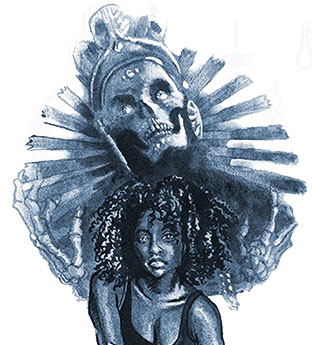
Geist: the Sin-Eaters 2nd Edition posted:
Those who died with no legacy left behind. Abiding Sin-Eaters hold oblivion at bay until they can forge something that will last beyond them.
The Abiding are perhaps the most stereotypical ghostly loiterers, sticking around because something was left undone. They are concerned with leaving a legacy behind, whether building one up or repairing one that has been damaged. They’re afraid of being forgotten
 , because that’s almost like never having lived in the first place. The legacies they concern themselves with can be grand, like finishing and submitting an architectural proposal for a literal monument, or more domestic, like bringing together an estranged family.
, because that’s almost like never having lived in the first place. The legacies they concern themselves with can be grand, like finishing and submitting an architectural proposal for a literal monument, or more domestic, like bringing together an estranged family.Abiding often attract geists that have their own unfinished business, seeking to work through the Bound to accomplish the half-remembered adventures cut short by their own death. Other geists attracted to the Abiding are more like cheerleaders or mentors, happy to prop up their Bound, lending them advice and power solely directed towards their goals. In either case they tend to egg on their Bound, whether to get what the geist wants personally out of the relationship or simply to encourage the Bound to keep chasing their own dreams.
Abiding that join Necropolitan krewes want to leave a legacy in both the living and the dead worlds. Being remembered by the living is intensely important to the dead, but being remembered fondly by your fellow dead doesn’t hurt. Abiding in Furies krewes go beyond protecting or rebuilding their legacy and seek vengeance on those who would damage it. Abiding Mourners concern themselves with maintaining and repairing the legacies of other dead. Abiding Pilgrims know that a legacy can be built by helping others, especially the downtrodden of the Underworld. Abiding Undertakers, like Mourners, help build and maintain others’ legacies, by teaching ghosts how best to do so themselves.
Example Bound: a dude who choked training for a hotdog-eating contest, a renowned chef that neglected her family who choked on a sausage, a spotlight-chasing lawyer looking to start a class action lawsuit against gangs (?!?) who was exsanguinated by a gang, an Olympic medalist who was slut-shamed to suicide over a sex scandal.
Example Geists: Le Magistrat who was an imposing judge in life and acts as legal counsel in death, the World Adventurer who speaks in different languages all at the same time but never got to travel the globe like they wanted, the Voice of Reason who offers film-making advice based on their life as a film critic. Other geist titles mentioned are the Watchdog, the Epicurean and the Gold.
The Bereaved
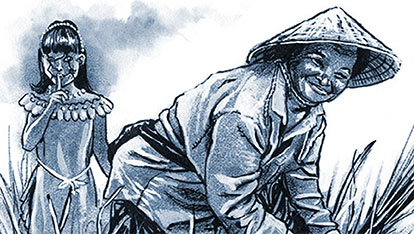
Geist: the Sin-Eaters 2nd Edition posted:
Those who lost someone dear to them — perhaps in the same incident that killed them, perhaps years before. The Bereaved scour the realms of the dead, seeking the fate of their lost loved ones.
The Bereaved are defined by their love for someone or something that they have lost, and a longing to find them or it again. Often this is a loved one—romantic, platonic, familial, it doesn’t matter. Bereaved can also pine for things like how their home town used to be growing up, or the circle of friends they had in college. They also didn’t necessarily die alongside whatever they lost. Some Bereaved linger decades before their own death takes them, and the pang of their defining loss is still so keen, so driving a force, it attracts a geist that offers them the chance to search the Underworld to reconnect.
Geists attracted to the Bereaved are rarely in the same depressive state as their Bound. Some are motivators of hope and cheer, knowing that somewhere out in the wide Underworld, the Bereaved can see their loved ones again. Other geists are simply emotional manipulators, exploiting the Bereaved’s overwhelming sadness and quest for lost love.
Necropolitan Bereaved tend toward small gatherings of the dead and rumination, but might instead organize the largest gathering possible in hope of stumbling into their lost loved one. Bereaved Furies temper a krewe’s outrage with how keenly they understand loss. Bereaved Mourners help others hold onto their own memories of lost love. Bereaved Pilgrims search for their lost love while they help ghosts move on, which is also an opportunity to sift through the teeming dead masses. Bereaved Undertakers are…sufficiently obsessed with their own bullshit that they can be “objective” about assisting other peoples’ journeys to and through death. I gotta admit I’m not crazy about this last one.

Example Bound: a cancer patient preceded in death by someone she met in her support group, a Chinese woman who killed herself and her unborn baby girl for lack of a son and the One-child Policy, a private eye whose mother disappeared when he was a kid.
Example Geists: Goyet Man who may in fact be the ghost of a pre-human hominid, the Caregiver who is addled and believes every child ghost is her lost child, the Bookie that always wheedles something in return for its services.
The Hungry
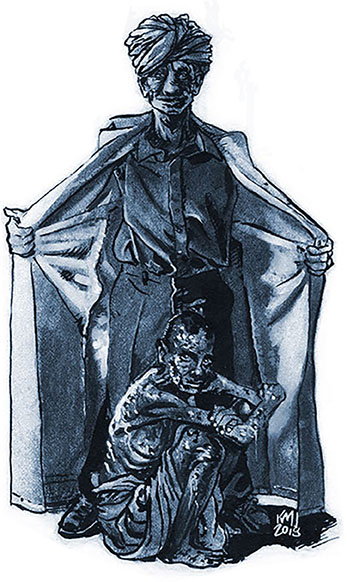
Geist: the Sin-Eaters 2nd Edition posted:
Those who left something behind they couldn’t bear to let go. They haunt the remnants of their lives and accomplishments, protecting what remains and hunting down that which was stolen.
The Hungry refuse to give up their “stuff and things.” This is almost entirely a temporal concern but not strictly material. They want to continue to be a wealthy jet-setter, keep on painting their Warhammer minis, keep stamping their passport until they’ve visited every country on Earth, keep watching a TV show they love. There’s obviously some overlap with the Abiding, here, but for the Hungry it’s more about personal possession and experience than leaving something worthwhile behind. Whatever it is, it’s theirs and they want to keep it. The Hungry attract geists of similarly materialist nature. While the Bound gets to keep doing what made them happy in life, they have to make some time to do the same for their geist. As long as their interests align, Hungry Sin-Eaters and their geists become close allies, partners in crime.
The Hungry don’t tend to have a natural end-point like other Sin-Eaters. Many of their obsessions are practically bottomless regardless of un-death, and even if all you wanted to do was finish your favorite show, there’s always a next favorite show after Big Bang Theory mercifully ends. This makes both Bound and geist particularly susceptible to bribery and manipulation, but they are nevertheless uniquely driven.
It’s natural for the Hungry to join Necropolitan krewes, since they best suit the celebratory nature of their Burden. They share their triumphs and bask in adulation. Hungry Furies make a habit of exploiting those they target—they “come off as corrupt cops.” Hungry Mourners are good at commiseration with and drawing upon the knowledge of the dead. Hungry Pilgrims are hypocrites, helping ghosts move on, for a price, while the Bound refuses to do so. Hungry Undertakers are keenly aware of how close they came to losing whatever keeps them going, and impress onto others how precarious their grasp is on what they love.
Example Bound: a guy who keeps building his dream-cabin getaway, a wizened octogenarian HIV/AIDS researcher this close to a vaccine, a Hollywood starlet who keeps chasing the next big role.
Example Geists: the Robber Baron, the Lumberjack, the Tattered Surgeon, the Tastemaker. As the Burdens go on the specific examples, even just one-off names, become lighter and sparser.

The Kindly
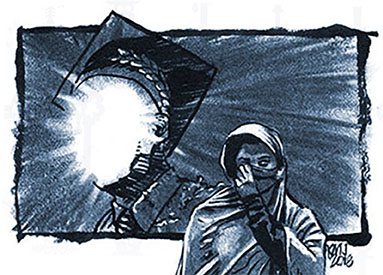
Geist: the Sin-Eaters 2nd Edition posted:
Those who, in death, recognize a great wrong they did in life and return to make amends. The Kindly redress personal wrongs and work to dismantle systems of exploitation they once benefitted from.
“Maybe all one can do is hope to end up with the right regrets” is one of the better quotes sprinkled in the Burdens. This defines the Kindly, Sin-Eaters that did something really bad and, probably, died as a result or from simple accident shortly after. They cheated on their spouse, abused their children, betrayed their best friend, embezzled from their business, etc. They want to mend the world, much like any other Sin-Eater, but the specific harm that they prioritize is the one they did. This can take the form of paying back loans—or “””loans”””—which is possibly a little easier if you didn’t die publicly, or being a weird creepy stalker who tries to help out your estranged family from the shadows.
Kindly geists likewise want to make amends, which often puts a lot on the Sin-Eater’s plate. Like any other geist, the “Kindly” ones are not necessarily good or altruistic outside of their own personal interests. They could be the ghost of an alcoholic who wants to save others from their fate. They could also just as easily see their Bound as a tool to fix their own regrets, using the Sin-Eater’s own mission to manipulate them.
An odd thing suggested in the Kindly is the possibility your geist is someone you died with. It doesn’t really align with everything else in the whole book about how ghosts and geists in particular work, and while it could be an interesting twist there’s no narrative or mechanical support for making it happen.
Necropolitan Kindly are doing their good works through the krewe, but can also use the group to lose themselves in celebration, burying their regrets. Kindly Furies feel like they know what wrongdoing is and so can dish out good justice. Kindly Mourners use their own crime to teach others what not to do. Pilgrim Kindly help put to rest the regrets of others, which should be a little cathartic considering their own motivation. Kindly Undertakers likewise help ghosts move on, though more by being enablers than doing all the work themselves.
Example Bound: a doctor who couldn’t find a suitable organ replacement for his wife, a teacher who acquiesced to ISIL-KP in front of her students and then was shot anyway, a documentarian that chose not to publish damning material for fear of government reprisal, a husband who cheated on his wife, a kid that shared tainted drugs with his date.
Example Geists: the Solemn Girl who cyber-bullied someone to suicide, the Blank Badge who was a cop that shot an unarmed man, the Empty Woman, the Blessed Mind, the Eyeless Watcher.
The Vengeful
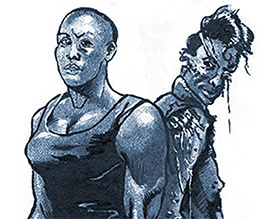
Geist: the Sin-Eaters 2nd Edition posted:
Those who blame another — rightly or wrongly — for their deaths and seek redress for the wrongs done to them.
The unfinished business of the Vengeful is hurting people. It might be vengeance against whoever is responsible for their death, or just whoever ruined their life but didn’t actually kill them. As with any vengeance, it can be petty as hell. Killing the target of one’s vengeance might be a satisfying conclusion to tracking down and confronting a powerful enemy, while ruining someone’s life is better suited to foes you have more control over, but nothing stops the Vengeful from being ridiculously, self-destructively petty toward dangerous antagonists. In fact, their geists might just encourage this bad habit.
The Vengeful often attract geists just as driven to destruction as their Bound, egging on the Sin-Eater’s rage and “justice.” Some are even drawn to Bound that will take their anger out on the geist, bizarre co-dependent relationships with an ultimately bloody purpose. Other geists may not be so angry or violent, but their sympathy and encouragement nonetheless enable the Sin-Eater’s outbursts.
Vengeful Necropolitans use the celebration of dead society to blow off steam and, of course, to direct them to new targets for their wrath. Fury krewes are a natural fit for the Vengeful, even in some sense reining them in by focusing their violence. Vengeful Mourners act as proxies for the vengeance of other dead. Vengeful Pilgrims tend to release their worldly attachments by destroying them, likewise helping ghosts the same way. Undertaker Vengeful still tend to resolve their obstacles through violence, but they at least put some thought into what is or is not an obstacle worth destroying.
Example Bound: someone killed by burglars, someone “driven to a sex worker” by their inattentive wife, someone who was already on a quest for vengeance when they died.
Example Geists: the Speed Demon, the Strangler, the Starvling Child.
KREWE ARCHETYPES
Similar to Burdens for individual Sin-Eater characters, krewe archetypes are broad categories that outline the nature of a krewe and its approach to the living and the dead. On top of the Bestow Regalia Ceremony that all krewes start with, each archetype determines three other Ceremonies that krewemembers can use if they have enough Mystery Cult Initiation.
Furies
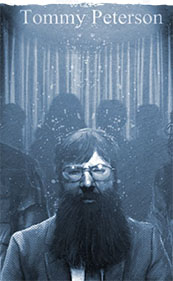
Geist: the Sin-Eaters 2nd Edition posted:
Krewes that focus on balancing the scales of justice. They put right that which is wrong.
Despite their name, Furious krewes are ideally concerned with justice, not simply punishment or vengeance. They seek not just to redress grievances but to mend the the rifts and systems that led to those grievances in the first place. This can take the form of tracking down someone to moralize at them, or just ruining their predatory business, or if all else fails putting the unrepentant down like animals. Furies are here to reform, and in the end they want to build a world that doesn’t need them. Until then it’s not enough just to fix the results of trespass, but to establish the rules that define what a trespass even is, and try to demonstrate these rules as guidance for others to make the world a better place.
Low-key Fury ceremonies often take the form of casual conversation or philosophical debates, arguments over challenging moral knots. Celebrants may act as audience to lectures, taking notes, or everyone might be a participant in interminable, raucous discourse. They are also partial to martial ceremonies, whether ritualized combat or simple pageantry.
Furious krewes have to watch out for overreach. Harshness and violence are tempting “cures” to immediate problems, and sometimes the consequences can seem not so bad. Furies that rein in their brutish impulses can still go too far. Good justice relies on evidence, and ghosts and ghostly super-powers make it easy to build a surveillance state. Even barring all that, Furies can overstep by appointing themselves arbiters of what other krewes should be doing to fix the Underworld.
Example Fury Krewes: Bizango may or may not be the secret ghost police arm of the real Haitian vodou organization. In any case, they try to keep a low profile, rooting out those who trespass against dead society and poisoning them (not usually fatally). Le Quatrième Etat is an underground journalistic outlet that exposes wrongdoing against the dead. They've recently taken down one of their own old, Bound allies who was into human trafficking, which got them a lot of praise but also side-eye from other, nervous allies. The Sodality of the Door concerns itself with protecting other krewes, particularly from the other supernatural denizens of the world. They prefer mediation but nonetheless know how to fall back on "ghost powers and baseball bats."
Mourners
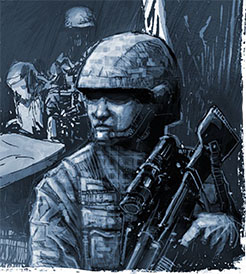
Geist: the Sin-Eaters 2nd Edition posted:
These Sin-Eaters remember the dead, especially those the living have forgotten. They bring light into the darkness of the Underworld and return with wisdom to share.
Mourners believe that nothing should be truly lost to death, from the meanest legacies of everyday nobodies to a late author’s unfinished masterpiece. What they uncover may not be suited for public consumption, but the krewe itself will know, and what matters is that someone remembers. Naturally, they act as repositories for knowledge and centers of research into the dead. Krewes that maintain regular contact with other Mourners can engage in spirited, friendly or not-so-friendly academic rivalry. As ghost-powered game protagonists, this preoccupation also tends to make Mourners into the Lara Crofts of the Underworld. Their ceremonies help preserve and pass on knowledge, and while these krewes often have strong traditionalist streaks they also incorporate plenty of modern trappings like server farms and Underworld-accessible wifi.
It’s easy for Mourner’s academic rivalry to turn sour, leading to spying and sabotage. Their facility for information-gathering can also tempt them to solve their problems with blackmail. Perhaps worst of all, the most depraved Mourners might be willing to destroy information in return for what they want.
Example Mourner Krewes: Supposedly a direct continuation of the ancient library, the Musæum of Alexandria makes its mission to catalog literally all information, in the living and dead worlds, for knowing's sake and to preserve it against the death of humanity. The Society for the Preservation of Endangered Martial Arts wants to catalog all the ways humans fight each other. This is not just a pugilist’s academic interest, as tons of cultural information is carried in the texts and traditions that pass on fighting styles. It can also have practical applications against ancient ghostly enemies. The Uknown Soldier Cult gathers artwork and stories from battlefields, even in places of ongoing conflict. They usually work in pairs with one Cultist serving on each side of the conflict, committing treason as they pass information back and forth.
Necropolitans
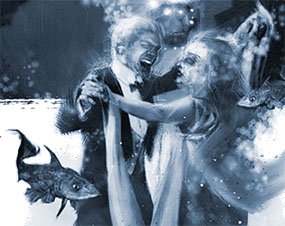
Geist: the Sin-Eaters 2nd Edition posted:
These krewes care for the dead, protect them from the depredations of the Underworld, and reunite them with loved ones across the veil.
“Celebrants” is never more apt a name than for members of a Necropolitan krewe. Their goal is to build a society for positive outlooks on life and death, obviously with a preoccupation for the latter considering the nature of Sin-Eaters. They are all about networking, whether through swanky parties, clubbing meetups, or even staying in touch with your friends online. The key to building a better life and afterlife is other people, to make those personal connections that can help focus your motivation or pull you back from the brink of despair. Ultimately, they don’t want to just make the Underworld better, they want the lands of the living and the dead to become friendly neighbors. This very public-facing goal can make more secretive krewes nervous. Necropolitan rites tend towards displays of togetherness and communication, and are often concatenations of all sorts of religious and folklore practices that emphasize community.
Like any hierarchy, Necropolis can become entrenched, adopting a self-importance and entangling itself with other power structures that exist for their own sake. Necropolitan krewes naturally trade in favors and status, a field of work ripe for individual and systemic abuse. They can also simply descend into debauchery, excusing their hedonism as religious ecstasy as they become pushers and dealers getting high on their supply.
Example Necropolitan Krewes: Taking the credit or blame for Sin-Eaters generally using the term “krewe”, le Krewe LaBas was formed after a fight between Mardi Gras Indian tribes in 1920 ended when dead from each side returned as Bound and embraced. These days they have a lot of business in the Underworld, and tend to act as a mentor organization for younger krewes. X-Treme Unction was founded in the 1990s and “is generally accepted to have the worst name of any krewe in history, but its members are really enthusiastic about it.” They’re an extreme sports club that treks to dangerous environments for rescue missions in the living and dead worlds. Not credited as a krewe by many, alt.gothic.ghost started out on Usenet but nowadays has a dedicated mobile app. Its members, themselves too old, too cloistered or otherwise impaired for traditional adventures, specialize in contacting ghosts that channel their powers through electronic devices.
Pilgrims
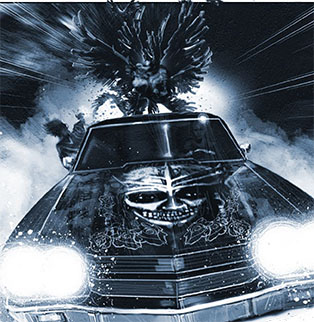
Geist: the Sin-Eaters 2nd Edition posted:
To Pilgrims, death is a step along a journey to something greater. They help the dead release their Anchors and come to terms with their demise.
“The Underworld isn’t a threat, it’s a challenge…” Pilgrim krewes see that death is a step after life, that there is another step after death. They want to gentle this journey and usher the dead along to transcend to whatever lies beyond. This philosophy combined with the nature of ghosts to move on by releasing their Anchors leads Pilgrims to view life and death as an exercise in controlling or shedding one’s attachments. While many Pilgrim krewes gather up their beliefs from ascetic Christian mystic traditions or psychoanalytic theory, a significant proportion of them are outright Buddhist sangha (monastic communities). Pilgrim rituals typically involve exploration of the Underworld and celebration of what good can be found there.
A preoccupation with understanding can also be a temptation to forge new attachments, and to grasp and overpower. Pilgrims studying the monstrous denizens and geography of the Underworld may stray into sympathy and emulation. Even Pilgrims who cleave to their mission of helping ghosts move on can lose their way, becoming too focused on the end and not the journey, inflicting what they think is best on their charges rather than teaching them how to truly let go.
Example Pilgrim Krewes: The First Church of Persephone, Architect studies and maps the structures of the Underworld, particularly those built outside of densely populated areas. Seeking to understand and master the waters of the Underworld, the Convivial Society of St. Christopher Souterrain often acts as Ferrymen, but also dive to shipwrecks in the living world to contact ghosts there. The Temple of Dogcatchers study and fight the worst monsters of the Underworld.
Undertakers
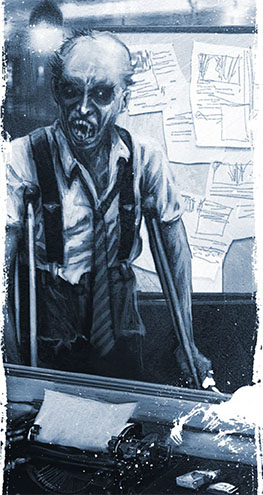
Geist: the Sin-Eaters 2nd Edition posted:
Undertakers help the living get their affairs in order before they become a ghost’s unfinished business. By changing how people perceive death and by understanding its metaphysics, they can change the game altogether.
Undertaker krewes seek to shape the Underworld and ghostly existence by changing the way the living view death. Death is at once totally expected and a surprise, and the Undertakers aim to change that. There is no ghostly torment if death is a soothe that leaves no ghosts behind, and for those that nevertheless become ghosts, the Underworld could be a paradise. They study the Dead Dominions to find the best of them, to figure out what seems to have worked and build on that. Their rituals tend to be traditional, as they believe those rites to lay the dead to peaceful rest are signposts laid by their philosophical forebears.
As a philosophy fundamentally about transforming other peoples’ practices and beliefs, it’s temptingly easy for Undertakers to fall back on just trying to control them through intimidation or subtler manipulations. Undertaker krewes also maintain close contact with the Underworld and gather its deep lore, which can become something of a commodity and turn them into power brokers. Arguably worst of all, their constant plumbing of the failures of the past can be disillusioning or even corrupting.
Example Undertaker Krewes: Schultheiss and Company is a PR firm that also does ghost-troubleshooting for big companies, and also cultivates child star Bound in some way. It’s kind of really vague. The Romsa Ludographical Institute is a department in Norway’s University of Tromsø that wants to use Nordic LARP to control the cultural narrative around the dead and Bound. Started in the 80's, Dispatches from Beyond the Veil takes the opportunity to talk plainly to its audience about the Underworld because it’s a conspiracy ‘zine so no one serious suspects a thing.
COMMENTARY
Burdens superficially seem like they suffer from a lot of overlap, a complaint that I can sort of understand and have seen, however I see this as a feature. Reducing Sin-Eater motivations to A Big Regret isn’t quite wrong, but the specific narrative arcs suggested by each Burden are pretty distinct. The Abiding, the Bereaved and the Kindly can all easily start out in very similar places, but their focus handily distinguishes their journey.
I like the krewe archetypes well enough, but I’m just a little unhappy that they’re the big, defining philosophy of your whole group, instead of each being one of the many philosophies it might contain. I’d prefer something a little less mechanically firm. Every remotely interesting krewe will include members with differing outlooks, or even ill-fitting celebrants who are better suited to other types of krewe. (That latter being a perfectly good source of drama!)
Geist loosens up how a lot of the usual templates for these game lines work, and I guess I wish it had gone just a little bit farther dislodging the “philosophical Y-axis splat.” It would be relatively simple removing starting Ceremonies from the krewe archetypes—and, for sanity’s sake, renaming the krewe archetypes to something else. Finding a way to make these philosophies more interactive and relevant would call for a lot more work, possibly adding whole new krewe subsystems. Oh well!
PS X-treme Unction is x-tremely good.
Next Up: Ghost-wizard lists! (Ceremonies, Keys and Haunts.)